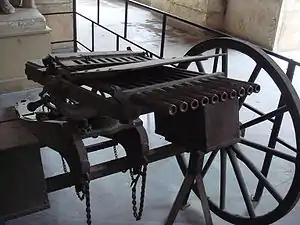List of weapons of the Philippine revolution
This is the list of the Weapons used in the Philippine revolution.
.jpg.webp)
Background

The Philippine Revolution, also called the Tagalog War by the Spanish,[1] was a revolution and subsequent conflict fought between the Katipunan, later the Philippine Revolutionary Army, and the Spanish colonial government.
Orders and circulars were issued covering matters such as building trenches and fortifications, equipping every male aged 15 to 50 with bows and arrows (as well as bolo knives and Gulok though officers wielded European swords), enticing Filipino soldiers in the Spanish army to defect, collecting empty cartridges for refilling, prohibiting unplanned sorties, inventories of captured arms and ammunition, fundraising, purchasing of arms and supplies abroad, unification of military commands, and exhorting the rich to give aid to the soldiers.[2][3]
List of Equipment
Spanish Colonial Government
- These are the weapons used by the Guardia Civil , Cazadores and the Spanish Army:
Rifles
.jpg.webp)
- Spanish M93 - Standard rifle - Primarily used by Guardia Civil.
- Remington Rolling Block rifle Both used by Cazadores and Guardia Civil.
Melee weapons
 A Sabre like this in photo are issued to the Spanish army officers
A Sabre like this in photo are issued to the Spanish army officers
Artillery
- Krupp gun
- Ordóñez guns - Spanish coast guard
 A Krupp gun used by the artillery regiments.
A Krupp gun used by the artillery regiments. An Ordóñez gun used by the Coast Guard.
An Ordóñez gun used by the Coast Guard.
Filipino Revolutionaries
- These are the weapons that used by the early and late Katipunan , and the Philippine Revolutionary Army from infantry, Tiradores , cavalry, artillery, sappers:[4] and even Muslim Filipinos.
Rifles
- Mauser Model 1893 - Standard rifle for Republican Army
- Remington Rolling Block rifle - Rifle issued to Tiradores (Sharpshooters).
- Muskets - Used in the prelude battles.
Melee weapons


.
- Bolo knife - standard melee of the Katipunero militias also known as Tagalog iták, Cebuano as súndang, Ilocano as bunéng and Hiligaynon as binangon.[6]
- Kalis - used by Moro people in Mindanao.[7]
- Sibat
- Balisong
- Gulok - used as a primary Sabre for enlisted officers.
- Barung Knives
- Spike bayonet
- Dahong palay
- Parang - Used primarily in Visayas and Mindanao.

 The Gulok used as a primary Sabre of enlisted officers.
The Gulok used as a primary Sabre of enlisted officers. The Dahong palay used by local militias.
The Dahong palay used by local militias. the Parang knife.
the Parang knife.
Artillery
- Krupp gun
- Ordóñez guns
- Lantaka's - used by the local villagers and specially in Mindanao.
 Two type of Lantaka a bronze type cannon use by the army.
Two type of Lantaka a bronze type cannon use by the army.
Other information
- The Bolo knife was the primary weapon used by the Katipunan during the Philippine Revolution.[9] It was also used by the Filipino guerrillas and bolomen during the Philippine–American War.[10][11] the bolo serves as a symbol for the Katipunan and the Philippine Revolution, particularly the Cry of Pugad Lawin. Several monuments of Andres Bonifacio, as with other notable Katipuneros, depict him holding a bolo in one hand and the Katipunan flag in the other.[12][13]
- The Filipino forces sometimes used improvised artillery weapons made of water pipes reinforced with bamboo or timber, which can only fire once or twice.[14]
- During the 1896 uprising against Spanish colonial rule the 1898 Philippine Revolution and the Spanish–American War, Filipino freedom-fighters (especially the Katipunan) sought assistance from the Japanese government. The Katipunan sent a delegate to the Emperor of Japan to solicit funds and military arms in May 1896.[15][16] Although the Meiji government of Japan was unwilling and unable to provide any official support, Japanese supporters of Philippine independence in the Pan-Asian movement raised funds and sent weapons on the privately charted Nunobiki Maru unfortunately, the ship sank before it reach to Philippine shores.
See also
References
- Bielakowski Ph.D., Alexander M. (January 2013). Ethnic and Racial Minorities in the U.S. Military: An Encyclopedia. ABC-CLIO. ISBN 978-1-59884-427-6.
- "Philippine–American War, 1899-1902". http://philippineamericanwar.webs.com. Retrieved 2012-01-28. External link in
|publisher=(help) - Linn 2000a, pp. 186–187
- "Uniformology II". Archived from the original on 2008-05-02. Retrieved 2008-05-20.
- Linn 2000a, pp. 186–187
- Dumindin, Arnaldo (2006). "Philippine–American War, 1899-1902". PhilippineAmericanWar. Retrieved 12 November 2014.
- Raiders of the Sulu Sea (Documentary). Oakfilms3, History Channel Asia. Retrieved 2009-02-08.
- Linn 2000a, pp. 186–187
- Wolfgang, Bethge (2007). "The Bolo - An indispensable Utensil in the Philippine Household". Insights-Philippines.de. Retrieved 12 November 2014.
- Mallari, Perry Gil S. (14 June 2014). "The Bolomen of the Revolution". The Manila Times. Retrieved 12 November 2014.
- Dumindin, Arnaldo (2006). "Philippine–American War, 1899-1902". PhilippineAmericanWar. Retrieved 12 November 2014.
- "Imprinting Andres Bonifacio: The Iconization from Portrait to Peso". Republic of the Philippines: Presidential Museum Library. 29 November 2012. Archived from the original on 11 September 2014. Retrieved 13 November 2014.
- "The Bonifacio Monument: Hail to the Chief!". Filipinas Heritage Library. The FHL Research Team. 12 November 2003. Archived from the original on 3 December 2003. Retrieved 13 November 2014.
- Linn 2000a, pp. 186–187
- "History Of Katipunan - Home On The Net". Katipunan.weebly.com. Retrieved 10 June 2013.
- http: //joserizal.nhcp.gov.ph/Biography/man_and_martyr/valenzuela_pio.htm
External links
- Philippines Independence Armies: Insignia 1896 - 1902
- * "Artemio Ricarte". Archived from the original on 2011-08-09. Retrieved 2012-01-28.

